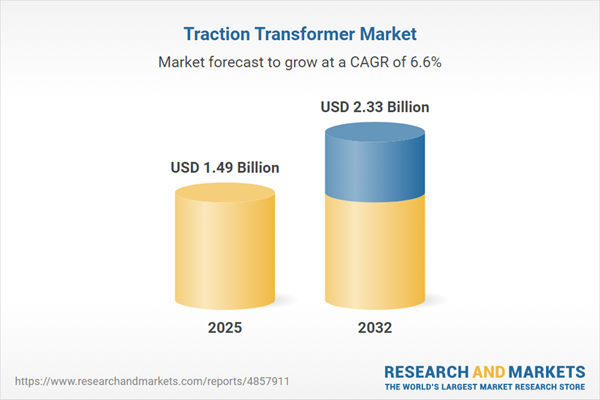Speak directly to the analyst to clarify any post sales queries you may have.
The traction transformer market is evolving rapidly as electrified rail systems expand globally, placing heightened focus on performance, efficiency, and adaptability. Senior decision-makers need a comprehensive view of the market's driving trends and actionable opportunities to guide strategic investments and operational planning.
Market Snapshot: Traction Transformer Market Overview
The traction transformer market grew from USD 1.40 billion in 2024 to USD 1.49 billion in 2025 and is projected to reach USD 2.33 billion by 2032, achieving a CAGR of 6.61%. This growth highlights the rising adoption of advanced transformer technologies supporting global electrification and network expansion efforts across the railway sector.
Scope & Segmentation
This report delivers in-depth analysis and future forecasts across the market’s crucial sub-segments to equip stakeholders for data-driven decision-making.
- Rolling Stock Applications: Freight locomotives, passenger locomotives, high-speed trains, and metros.
- Mounting Positions: Machine room, underframe, and roof-mounting in rolling stock applications to address various space and performance needs.
- Overhead Line Voltage Platforms: AC (12 kV, 15 kV, 20 kV, 25 kV) and DC (0.75 kV, 1.5 kV, 3 kV) systems, each demanding specific insulation and winding technologies.
- Cooling Methods: Air-cooled and liquid-cooled technologies, meeting diverse requirements for maintenance ease and thermal capacity.
- End Users: Government rail authorities, locomotive manufacturers, private rail contractors/operators, and urban transit systems, each presenting unique technical priorities and procurement cycles.
- Regional Coverage: Americas, Europe, Middle East & Africa, and Asia-Pacific—with analysis on major geographies such as North America, Brazil, Western Europe, the Middle East, China, India, and Southeast Asia.
- Key Companies Assessed: ABB Ltd., Fuji Electric Co., General Electric Company, Hitachi Ltd., Jiangshan Scotech Electrical Co., Mitsubishi Electric Corporation, Schneider Electric SE, Siemens AG, Toshiba Corporation, and others.
Key Takeaways for Traction Transformer Market Leaders
- Electrification and sustainability targets are driving product innovation, with traction transformers evolving into intelligent, digitally connected platforms for data insights and predictive performance.
- Advances in materials science are enabling more compact and energy-efficient transformer designs, supporting the modernization of both high-speed and urban rail systems.
- Technical standards and interoperability requirements are growing in importance as cross-border rail movements and supply diversification increase, requiring close monitoring of regulatory frameworks.
- New maintenance models, leveraging digitalization and embedded sensors, help rail operators optimize asset lifespans and reduce unplanned downtime, enhancing operational continuity.
- Competitive dynamics reflect a blend of organic R&D and strategic partnerships, as global suppliers pursue digital integration, modularity, and regionally tailored production to strengthen their market positions.
Tariff Impact: Navigating Supply Chain Realignment in 2025
Revised U.S. import tariffs introduced in 2025 have increased input costs for manufacturers dependent on international suppliers, particularly for core components. Leading market participants are responding by exploring nearshoring alternatives and investing in local production capabilities. This realignment is fostering greater regional self-sufficiency but also creates transitional challenges, such as workforce reskilling and the deployment of new quality assurance measures. Strategic alliances and supply diversification are proving essential to maintaining delivery reliability and margin stability in this shifting landscape.
Primary Research Methodology & Data Sources
This report leverages primary interviews with senior rail operators, equipment manufacturers, and engineering planners, supported by secondary analysis from industry publications, regulatory filings, and proprietary project databases. Rigorous data triangulation and peer review underpin the reliability and accuracy of all findings.
Why This Report Matters for Decision-Makers
- Enables operational and investment strategies that align with rapid rail electrification, sustainability mandates, and the evolving digital rail landscape.
- Provides transparent insights into how policy shifts—such as tariffs—and regional market nuances affect sourcing, design, and deployment decisions.
- Empowers stakeholders to identify partnerships and technologies critical for sustained competitiveness and supply chain resilience.
Conclusion
The traction transformer market is entering a transformative phase shaped by technology, policy, and global infrastructure growth. Decision-makers equipped with forward-looking insights from this analysis can confidently navigate complexity, reduce risks, and seize emerging opportunities across the global rail sector.
Additional Product Information:
- Purchase of this report includes 1 year online access with quarterly updates.
- This report can be updated on request. Please contact our Customer Experience team using the Ask a Question widget on our website.
Table of Contents
3. Executive Summary
4. Market Overview
7. Cumulative Impact of Artificial Intelligence 2025
Companies Mentioned
The companies profiled in this Traction Transformer market report include:- ABB Ltd.
- Fuji Electric Co., Ltd
- General Electric Company
- Hitachi, Ltd.
- International Electric Co., Ltd.
- Jiangshan Scotech Electrical Co., Ltd.
- Mitsubishi Electric Corporation
- Schneider Electric SE
- Siemens AG
- Toshiba Corporation
Table Information
| Report Attribute | Details |
|---|---|
| No. of Pages | 187 |
| Published | November 2025 |
| Forecast Period | 2025 - 2032 |
| Estimated Market Value ( USD | $ 1.49 Billion |
| Forecasted Market Value ( USD | $ 2.33 Billion |
| Compound Annual Growth Rate | 6.6% |
| Regions Covered | Global |
| No. of Companies Mentioned | 11 |









